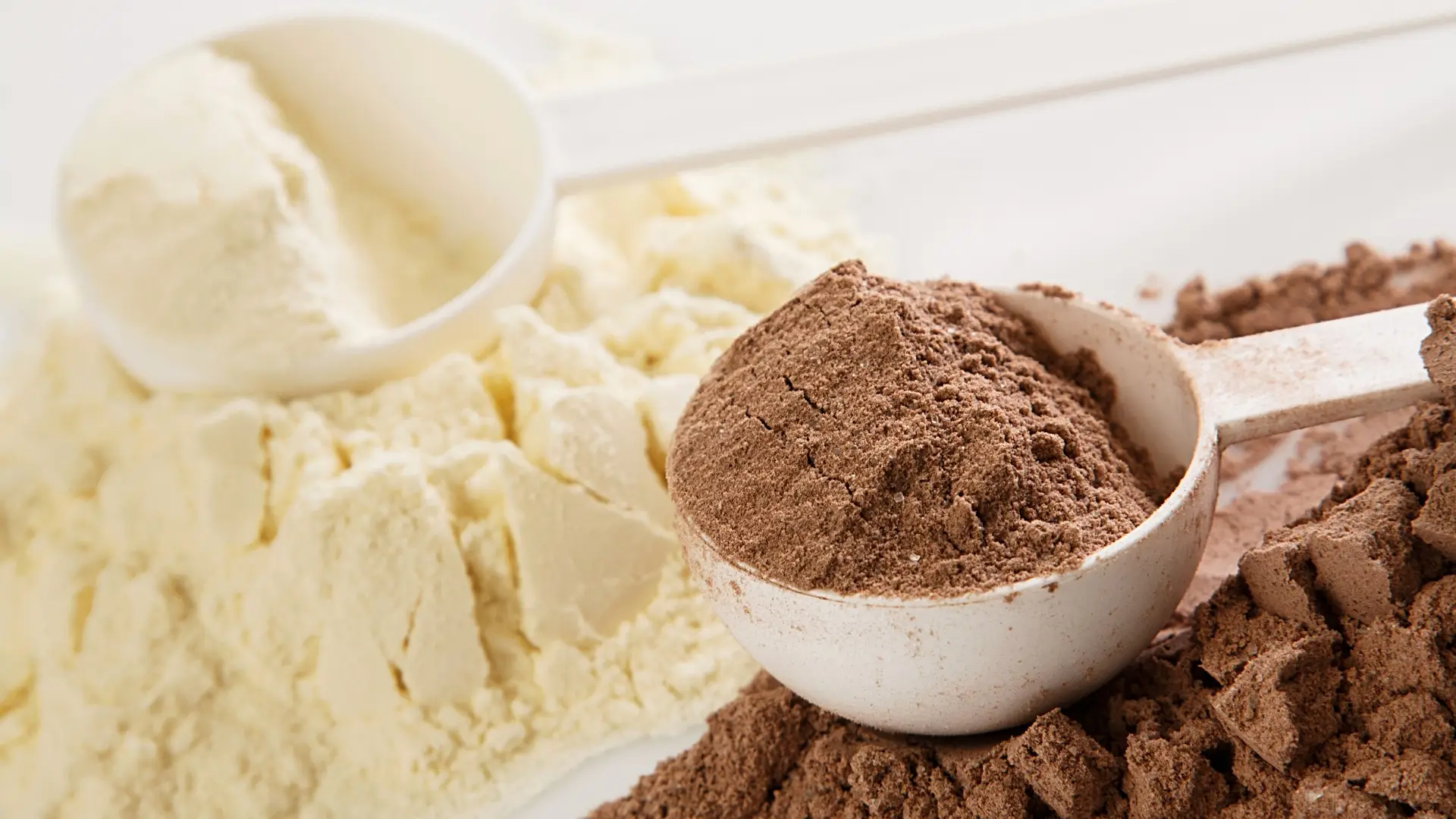Everything You Need To Know About Protein Powders
One of the most popular (and completely unnecessary) food supplements in the fitness industry is whey protein powder. Commonly used to get more protein in your diet, directly after your training session to cover the post-workout “anabolic window” or used as a high-protein flavoring agent for oatmeal or pancakes. It’s arguably the easiest way to get additional protein in as powdered whey dissolves relatively easily in water and doesn’t require any cooking or meal prep before consumption. In this article, we’ll look at the best options available and why most versions of whey protein should generally be avoided if you care about your appearance & physical development!
Whey Protein Powders
Originally a by-product of cheese production, whey protein is currently produced with 2 different separation methods. One method utilizes ion exchangers, which extract native whey protein from the whey stream, according to the surface charge characteristics of the whey molecules. This extraction method is known to create the purest whey protein dairy separations. It uses mild pH adjustments to activate and subsequently deactivate the attraction between the ion exchange resin and the protein molecules. While the proteins are bound to resin temporarily, the non-protein components of cow dairy are thoroughly washed from the reactor. Although strong acids & bases are used for the adjustment, the rise in pH levels is quite small and within the range commonly found in unprocessed foods. Changes in protein conformation within this acidity range are reversible and are not considered to denature the protein. Ion exchange is highly specific to native whey proteins and is generally more selective in which molecules are retained during the separation process.
Membrane filtration is the second method of whey protein separation and typically uses a combination of micro-filtration & ultra-filtration, which uses its molecular size as the basis for separating components from the whey stream. Pressure is applied across a membrane surface, which forces smaller molecules through the membrane while larger molecules are retained. Compared to the ion exchanger method of separation, membrane filtration is somewhat less selective allowing any molecule to be retained within the size range. This means that whey proteins produced by membrane filtration contain a significant amount of casein proteins, which have a larger molecule size, less complete amino acid profile, and less Branched-Chain Amino Acids (BCAAs) within.
Whey proteins have very high bioavailability compared to food and are quickly absorbed into the body. They also have a relatively high concentration of BCAAs, which are essential for the repair & growth of muscle tissue. Whey protein isolates are also widely used in infant breast milk formulas to provide amino acids for optimal growth & development. Whey isolates are also used as protein fortification for meal replacement bars, sports beverages, dairy products, extruded snacks & cereals, and many other food products.
Whey Concentrate
Whey protein concentrate is the cheapest and most common form of whey protein used in fitness nutrition supplements. Whey concentrates typically have a low (but still significant) amount of carbohydrates (lactose), fat & cholesterol.
It can be used post-workout as part of an offseason growth phase where calories don’t have to be restricted and the additional carbs & fats in the protein powder will provide additional calories for growth & recovery.
(Hydrolyzed) Whey Isolate
Whey protein isolate is a further processed form of whey by separating the whey stream components by the ion exchange method. Whey isolates contain a higher percentage of pure whey protein with a lower amount of carbohydrates, lactose, fat & cholesterol compared to whey concentrates. Isolates come in various grades, including hydrolyzed whey isolate, which virtually carb, lactose, fat & cholesterol free, but still contains trace amounts of non-protein components.
Isolate can be used either pre- or post-workout during a cutting phase where calories are restricted, and the consumer is merely looking to increase protein intake for recovery, with minimal additional calories to keep fat loss going.
Whey Hydrolysate
Whey protein hydrolysate has special application in sports medicine because its consumption allows amino acids to be absorbed by the body more rapidly than intact proteins, thus maximizing nutrient delivery to muscle tissues by bypassing the need for digestion. It has been partially digested with a Protease (Trypsin or Elastase), further increasing its bio-availability.
Whey hydrolysate only contains trace amounts of carbohydrates, lactose, fat & cholesterol and doesn’t use any flavoring agents, unlike commonly added to concentrate & isolate formulations. Whey hydrolysate is the most soluble of all whey protein powders and is always sold unflavored. Unfortunately, it’s not readily available due to its bitter taste!
Hydrolysate is best used as part of an intra-workout shake as it digests very rapidly. In order to cause a more stable rate of absorption, hydrolysates can be consumed over the course of 1-1.5 hours, which allows muscle tissue to absorb the amino acids without the excess being converted to glucose through gluconeogenesis within the liver. While all whey proteins are subject to gluconeogenesis as they’re more easily absorbed compared to food sources of protein, which require digestion of several hours, whey hydrolysate appears to cause the most gluconeogenesis of all whey protein variations due to its rapid absorption into the bloodstream. If you don’t space the consumption of hydrolysate out over the course of an hour or two, or combine it with food to slow gastric emptying, a large portion will be converted into glucose, making it a very expensive form of sugar…
Hydrolyzed Caseinate
Casein protein is often used in coffee creamers, soups, toppings, thickening agents, or food stabilizers. Casein easily dissolves & disperses into the water, making it as soluble as hydrolyzed whey protein. However, unlike hydrolysate, the casein molecules can form a gel or clot inside the stomach, slowing it’s digestion and providing a more sustained release of amino acids into the bloodstream. This makes casein more suitable as pre-workout nutrition, slowly releasing proteins while you’re training and a few hours afterward. In supplemental form, it’s available as hydrolyzed caseinate, which has been partially digested with a protease (Trypsin, Caseinase, or Elastase), further increasing it’s bio-availability.
Similar to whey hydrolysate, hydrolyzed caseinate takes bitter, and flavoring agents are often added to mask its natural taste. Caseinate comes either as sodium-caseinate or calcium-caseinate, often used to increase the calcium content of processed foods. Sodium-caseinate is used for most hydrolyzed protein formulations, making its sodium content the highest of all protein powders!
Collagen Protein Powders
Besides dairy-based protein powders, several other protein powders are available in the supplement industry. Animal sources are used to create protein powders as well, where bovine (beef) sources are seen to be preferred as they have a much higher glycine to methionine ratio compare to whey proteins. Bodybuilders, strength athletes & fitness enthusiasts usually eat a lot of muscle-meat in their diet, which contains methionine predominantly. High dietary methionine can deplete glycine levels during a process known as methylation.
There is no consensus of an optimal glycine to methionine ratio. Coach Steve has been following a ratio of 2:1, which improved tendons & ligament health tremendously. Results become very noticeable within several months of supplementing with bovine protein powders compared to using whey proteins before!
Collagen is the most important & abundant protein in connective tissue, skin & bones. The body contains more collagen compared to any other type of protein. When your diet lacks sufficient amounts of collagen, the skin will become wrinkly, and the connective tissue will weaken to the point of increased risk of injury. In severe cases, collagen deficiency can lead to osteoporosis.
There are 5 main kinds of collagen; some are available in supplement form, although the body can synthesize most collagens from dietary collagen sources or Essential Amino Acids (EAAs). Below is a list of collagen types that are found is specific human tissue(s), and the corresponding dietary source to supply that particular collagen type:
• Collagen Type 1: Skin, Tendon, Vasculature, Organs & Bone. White fish & beef are the best dietary source of Collagen Type 1.
• Collagen Type 2: Cartilage. Chicken Bone Broth is the best dietary source of Collagen Type 2.
• Collagen Type 3: Connective Tissue (Reticulate Fibers). Beef is the best dietary source of Collagen Type 3.
• Collagen Type 4: Basement Membrane in Skin, Respiratory Tract & Gastrointestinal Tract. Eggs are the best dietary source of Collagen Type 4.
• Collagen Type 5: Cell Surfaces, Hair & Placenta.
Beef Collagen Peptides Type 1 & 3
Bovine collagen is often hydrolyzed from their skin, joints, or tougher meats, which is left over from the meat extraction process. The bovine hide, tendons, cartilage & meat left-overs are boiled for a prolonged period of time until they are reduced to a thick liquid, which is then purified with membrane filtration methods until only the collagen proteins remain. After the separation of proteins, a protease is added to hydrolyze the collagen into more bio-available peptides, which are easier digested & absorbed when consumed in supplemental form.
Beef Collagen Peptides on iHerb: https://www.iherb.com/pr/Sports-Research-Collagen-Peptides-Unflavored-16-oz-454-g/71106
Beef Gelatin
Bovine gelatin produced from their bones, which is are also left over from the meat extraction process. The bones are boiled for a long time until they are reduced to a gelatinous liquid, which is then purified with membrane filtration methods until only the gelatin proteins remain. However, unlike with bovine collagen, gelatin isn’t hydrolyzed. During the production process, no protease is added to increase the bio-availability of the collage powders. This makes bovine collagen peptides more readily absorbed compared to bovine gelatin.
In terms of health benefits, both collagen & gelatin mostly consist of the same amino acids and should yield similar protein synthesis in skin & connective tissue after consumption. Some athletes notice that hydrolyzed collagen peptides are easier on their intestinal tract compared to gelatin. Coach Steve found that combining both bovine protein powders in a 1:1 ratio provides the best benefits regarding muscle recovery & growth, given the bovine protein is supplemented around the workout.
Another added benefit of collagen & gelatin powder is these supplements don’t contain any carbohydrates, fat, or cholesterol, making it suitable to be used either offseason or during a cutting phase!
Beef Gelatin on iHerb: https://www.iherb.com/pr/Sports-Research-Beef-Gelatin-Collagen-Protein-Unflavored-16-oz-454-g/75242
Fish Collagen Peptides Type 1
Some people aren’t able to eat beef due to religious beliefs (Hindus) or as part of their vegetarian restrictions (Pescatarians) but can eat fish to get adequate protein in their diet. They can consider using hydrolyzed fish collagen protein to get supplement additional collagen to their diet.
Coach Steve likes to warn you ahead of time; this kind of protein powder requires an acquired taste, it’s definitely not for everybody! Coach Steve prefers bovine collagen over fish collagen peptides, he hasn’t found a way to make it palatable in its raw powdered form…
Fish collagen peptides are best consumed when they’re mixed with oatmeal and maybe some banana (or Stevia), depending on the phase of your diet, as part of your post-workout meal. Coach Steve doesn’t recommend this supplement as part of a pre- or intra-workout nutrition protocol, due to its taste and how it sits in your stomach. If you can stand the taste, post-workout mixed with oatmeal to slow digestion and mask the flavor seems to be acceptable for most people.
Remember that fish doesn’t contain collagen type 3, so you’ll lose the benefits for connective tissue when you decide to take fish collagen over beef collagen.
Plant-Based Protein Powders
Besides whey & animal protein powders, several plant-based protein powders are available on the market as well. Mostly aimed towards vegetarians, these products require several extraction processes to refine the protein content of plants, which are typically low in protein and generally have poor amino acid profiles. Soy & pea protein powders seem to be the most popular and are considered to have the best amino acid profile. However, there are many plant-based protein powders on the market, including; hemp, brown rice, pumpkin seed, sunflower seed, chia, as well as several blends consisting of different plant sources.
Micro-Nutrient Comparisons
I’ve included a few comparisons of the most commonly used protein powders that are readily available; the nutritional information was taken from unflavored versions. Keep in mind that Coach Steve is extremely limited by the nutritional information that’s provided by supplement companies. Most do not list the amino acid profile of their products, as well as the micro-nutrients contained within the protein powders. Coach Steve was able to find the amino acid profile for most of the protein powder variations, but this sheet is by no means accurate or complete. Consider it a tool to compare each type of protein powder or food source’s nutrition profiles to see which products complement your goals the best!

The top half of the sheet compares 10 protein powders to each other, ordered to their respective protein content. Below are 8 commonly used animal protein sources, so you can compare the amino acid profile & micro-nutrients.
While the bottom half lists the same protein sources again, the portions are increased to get around 100 grams worth of protein per serving. This results in a tremendous increase of caloric content for some of the protein powders or food sources, as some options have additional carbs & fats, which increase alongside their protein content.
Interestingly, 920g egg whites yield only 445 calories, compared to 525 calories from 140g whey concentrate; both give you approximately 100g protein! You can immediately see why food sources are always the better option; not only is the BCAA content of food relatively close to what’s available in protein powders, real food also gives you a wide range of micro-nutrients, which aren’t present in any of the protein powders!!
Collagen & plant-based protein powders are considerably low in essential BCAAs, especially compared to whey protein powder. However, they do contain equivalent amounts of glycine (especially collagens), making them a suitable supplement to be used to improve connective tissue!
Caseinate is very high in the amino acid tryptophan, which is the main building block for 5-Hydroxy-Tryptophan (5-HTP), a precursor to Serotonin. Serotonin contributes to an overall sense of wellbeing, improves sleep quality & suppresses appetite. This makes caseinate protein powders a suitable bedtime supplement! It’s also high in tyrosine, which helps with energy production during workouts, another reason why Coach Steve prefers to use hydrolyzed caseinate as part of a pre-workout formula!








